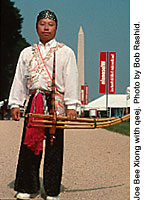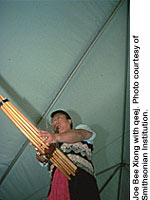|
Home | Search | The Artists | Teaching | Hiring | About This Site | Contact Us |
||

Joe Bee Xiong’s |
Hmong Traditional Music
The bamboo tubes have one finger hole. When Joe Bee covered a hole, air was forced through the reed. When he didn't cover a hole, the tube was silent. Qeej players usually play two or three notes at a time. The blending of the sounds makes harmonies and counterpoint. The bamboo tubes are bundled together and attached to a wooden wind chamber that holds air like the bag on a bagpipe. The wind chamber allows the qeej to play a constant, steady drone. The chamber’s steady air means the qeej keeps playing notes even when the musician pauses to take a breath.
The dance style comes from an ancient form of a Chinese martial art. Long ago, qeej players held competitions where they would play music and do battle using their feet at the same time. They don’t compete like that anymore but the movements have stayed with the music. |
For Educators: |
|
“The gheng player is not only a musician, but a dancer, a song-writer, an actor and a poet.” – Joe Bee Xiong |
||
|
Home | Search | The Artists | Teaching | Hiring | About This Site | Contact Us |
||

 Joe Bee explained that the qeej is made from six bamboo pipes that have
been soaked, steamed and bent into gentle curves. Each pipe contains a free reed. The free reed
Joe Bee explained that the qeej is made from six bamboo pipes that have
been soaked, steamed and bent into gentle curves. Each pipe contains a free reed. The free reed  Have you ever seen someone play the qeej? If so,
you probably saw him move around a lot while he played. Part of the art of playing a qeej is dancing. The qeej player dances as he plays the instrument, often in a crouching position.
Sometimes the player spins or hops on one foot.
Have you ever seen someone play the qeej? If so,
you probably saw him move around a lot while he played. Part of the art of playing a qeej is dancing. The qeej player dances as he plays the instrument, often in a crouching position.
Sometimes the player spins or hops on one foot.